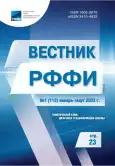Digital Education Platform
- Authors: Bakhteev O.Y.1, Dyatlova O.V.2, Leonov A.G.3, Gafarov F.M.4, Kosaretsky S.G.5, Sergeev A.N.6, Grinshkun V.V.7, Kudinov V.A.8, Shcherbatykh S.V.9
-
Affiliations:
- Dorodnicyn Computing Centre of RAS
- Institute of Psychology, RAS
- Scientific Research Institute for System Analysis, RAS
- Kazan Federal University
- Pinsky Centre of General and Extracurricular Education, Institute of Education, NRU HSE
- Volgograd State Social and Pedagogical University
- Moscow City University
- Kursk State University
- Bunin Yelets State University
- Issue: Vol 113, No 1 (2022): Digital transformation of secondary school
- Pages: 87-103
- Section: THEMED SECTION: FUNDAMENTAL SCIENTIFIC RESEARCH IN THE FIELD OF NATURAL SCIENCES
- URL: https://bakhtiniada.ru/1605-8070/article/view/304361
- DOI: https://doi.org/10.22204/2410-4639-2022-113-01-87-103
- ID: 304361
Cite item
Full Text
Abstract
Today there are different understandings of what is considered part of a digital platform, what is on it and what is available through it. A digital integrated implementation of the following functions is required, regardless of how we define their relationship with the platform:
— support for group communication with the ability to record the process;
— accounting for the roles of the student, teacher, administrator, parent; automatic generation of digital journals and report cards;
— formation of the history of individual work and recording of educational events of the student, teacher, class; including it in the big data of education;
— designing an individual path for students to achieve educational goals with a choice of those posted on the platform; selection and implementation of tasks offered by the teacher;
— placement the goals, assignments, feedback and assessment tools, other learning materials;
— accommodating student learning requests and suggestions from teachers, organizations, and educational programs that go beyond the boundaries of one school;
— recording learning outcomes; displaying and forecasting on the basis of big data of the educational process with varying level of detail.
The digital platform helps the teacher get rid of routine reporting. It opens up new possibilities for pedagogy of dignity and cooperation.
About the authors
Oleg Yu. Bakhteev
Dorodnicyn Computing Centre of RAS
Author for correspondence.
Email: bakhteev@phystech.edu
Russian Federation, 14 Leninsky Ave., Moscow, 119991, Russia
Olga V. Dyatlova
Institute of Psychology, RAS
Email: dyatlovaolga@gmail.com
Russian Federation, 13-1 Yaroslavskaya Str., Moscow, 129366, Russia
Alexander G. Leonov
Scientific Research Institute for System Analysis, RAS
Email: dr.l@math.msu.su
Russian Federation, 36-1 Nakhimovsky Ave., Moscow, 117218, Russia
Fail M. Gafarov
Kazan Federal University
Email: fgafarov@yandex.ru
Russian Federation, 35 Kremlin Str., Kazan, 420008, Republic of Tatarstan, Russia
Sergey G. Kosaretsky
Pinsky Centre of General and Extracurricular Education, Institute of Education, NRU HSE
Email: skosaretski@hse.ru
Russian Federation, 16-10 Potapovsky Lane, Moscow, 101000, Russia
Aleksey N. Sergeev
Volgograd State Social and Pedagogical University
Email: alexey-sergeev@yandex.ru
Russian Federation, 27 Lenin Ave., Volgograd, 400005, Russia
Vadim V. Grinshkun
Moscow City University
Email: vadim@grinshkun.ru
Professor, RAE Academician
Russian Federation, 4 2nd Selskohozyaystvenny Pass., Moscow, 129226, RussiaVitaly A. Kudinov
Kursk State University
Email: kudinov@kursksu.ru
Professor
Russian Federation, 33 Radishchev Str., Kursk, 305000, RussiaSergey V. Shcherbatykh
Bunin Yelets State University
Email: shcherserg@mail.ru
Professor, Acting Rector
Russian Federation, 28 Kommunarov Str., Yelets, 399770, Lipetsk reg., RussiaReferences
- F.M. Gafarov, E.G. Sabirova, D.V. Avdeeva Rol iskusstvennogo intellekta v obrazovanii [The Role of Artificial Intelligence in Education], 2021, 9 pp. (in Russian). (https://rffi.1sept.ru/article/492).
- A.A. Zaslavskiy Ierarkhicheskaya struktura sposobov primeneniya chatbotov pri avtomatizatsii postroenia individualnykh obrazovatelnykh traektoriy [Hierarchical Structure of Ways to Use Chatbots in Automating the Construction of Individual Educational Pathways], 2021, 5 pp. (in Russian). (https://rffi.1sept.ru/file/2021/11/34322e6e-faa3-4dea-8638-18450e483b41.pdf).
- O.V. Dyatlova, I.A. Elman, R. I. Krivonogov Yaroslavl Pedagogical Bulletin [Yaroslavsky pedagogichesky vestnik], 2021, №5(122), 185 (in Russian). doi: 10.20323/1813-145X-2021-5-122-185-194.
- Yu.D. Kersha, A.S. Obuhov Problems of Modern Education [Problemy sovremennogo obrazovania], 2021, №5, 35 (in Russian). doi: 10.31862/2218-8711-2021-5-35-48.
- N. Besshaposhnikov, M. Dyachenko, A. Leonov, K. Mashchenko, K. Prokin Osobennosti realizatsii cheloveko-mashinnogo interfeysa dlya detey doshkolnogo vozrasta v kurse algoritmiki s ispolzovaniem sistemy PiktoMir [Features of the Implementation of the Human-Machine Interface for Preschool Children in the Course of Algorithms Using the PictoMir System], 2020, 1 pp. (in Russian). (https://rffi.1sept.ru/article/159)
Supplementary files








